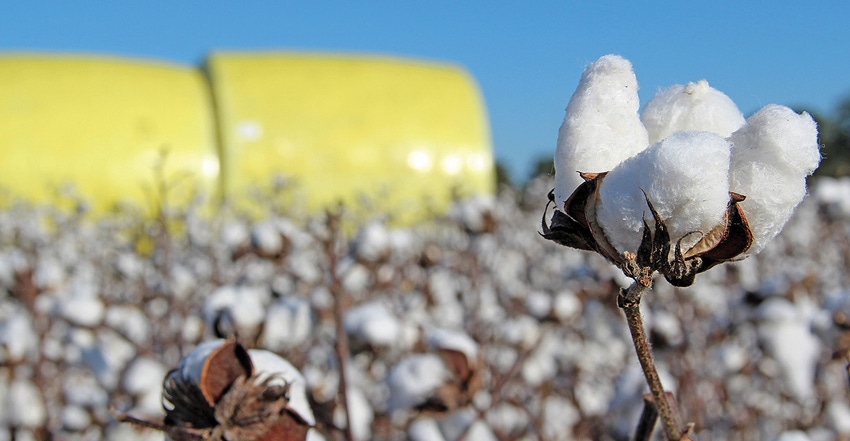
The economic outlook for corn, cotton, and soybean producers has improved dramatically since summer 2020. Prices are up across the board, and trade expectations are promising.
Agriculture, however, lives with uncertainty. Factors such as weather, planting intentions, and export unpredictability will affect markets.
Staying abreast of changing conditions will be essential as farmers harvest 2021 crops and begin planning for 2022.
University of Tennessee Extension Economist Aaron Smith offered insight into how the market has changed in a year and what factors could influence prices going forward.
Where are corn, cotton, and soybean prices compared to where they were a year or so ago? What are the basics supporting the current market?
Prices are up dramatically compared to last year. On July 30, the December corn contract closed at $5.48 ¾, $2.22 higher than July 30, 2020. Similarly, November soybeans were $13.52 ¼, $4.64 higher than last year, and December cotton was 89.6 cents, 26.42 cents higher than the previous year. In addition to higher futures price, basis has also been very strong across Tennessee.
Corn and soybean prices are down from highs in May and June but remain very strong heading towards harvest. It is important to note that a great deal of uncertainty remains in U.S. production and exports to China, which could create dramatic changes in prices.

How has the agriculture trade situation changed? What are the near-term expectations and things to watch for?
In 2020, China accelerated purchases of many agricultural commodities in late summer, which drove prices up and facilitated the 2020/2021 price rally for corn, soybean and cotton. Recently, export pace to China has slowed; however, China purchasing for the 2021/22 marketing year remains highly uncertain and difficult to predict.
What are the best marketing and risk management practices going forward?
From a marketing standpoint, producers need to estimate 2021 production and then look at how much they have priced to date. Producers should also evaluate storage capacity relative to production and the amount of production priced. Extending the marketing window through storage opens additional marketing options.
Using a short hedge can be challenging given the volatility we have seen in markets; this can increase liquidity requirements to meet margin. Using out of the money options to remove downside risk is a simple strategy that producers may want to consider. For example, buying a $12 November soybean put option for 11 cents can remove approximately 90% of futures price risk on the protected bushels. Producers interested in implementing futures and options strategies should work with a qualified professional to ensure they understand the risks and benefits of different strategies.
If producers do not have on-farm storage or if current capacity is inadequate, is it prudent to invest in more? Producers without permanent on-farm storage can consider temporary storage (bag storage), commercial storage, or taking a financial position through futures or options. Bag storage is a possibility if the producer has access to equipment (custom bagging or purchasing the bagging equipment). Commercial storage may be limited, depending on location, but investigating prevailing rates in your area is worthwhile.
Through futures and options markets, producers can take a financial position after the sale of the cash commodity that allows them to participate in a future market rally. All three options should be thoroughly evaluated, and the risks/rewards understood.
Investment in storage should be considered as part of a long-term marketing strategy. Currently, construction costs and materials can be prohibitive to investing in additional on farm storage. Additionally, access to materials and having storage systems built in a timely manner remain problematic. Penciling out costs, tax implications, and anticipated benefit is the only way to determine if increasing on-farm storage makes sense for your business.
What about low-cost storage options or commercial storage?
Access to commercial storage can be limited in many regions in the Southeast. However, available costs and terms should be investigated to see if it makes financial sense. Understanding local basis and estimating seasonal price appreciation will be a critical step to determine if commercial storage is worth pursuing.
Best guess on what’s ahead for the next year or longer?
Prices are likely to remain reasonably strong for corn, $5.00+, soybeans $12.00+, and cotton 80 cents+ as we move into harvest and winter. However, there is a great deal of uncertainty due to:
2021 national average yields are largely unknowns, and things can change dramatically (like the derecho and flash droughts).
Projected exports to China are highly uncertain.
Global demand is strong, but COVID-19 resurgence could taper demand.
Brazil plantings/production could be another record due to high prices.
Longer term, high prices will pull in additional production domestically and from foreign sources that will increase the supply.
Considering current and anticipated commodity prices, but also the uncertainties, will this be a good year to replace equipment or expand operations?
Equipment costs and availability are concerns. Prices across a broad spectrum of equipment and inputs have appreciated substantially in the past year, so finding a “good deal” may be challenging.
Purchases of necessity will still need to occur, but likely at an elevated cost. Having a multi-year replacement plan for key pieces of equipment is a good idea. Purchasing equipment for tax purposes should be done cautiously.
The benefit of maintaining/building liquidity and flexibility for future purchase decisions should not be underestimated during high price periods.

As Sunbelt corn, cotton, and soybean producers complete the 2021 harvest, they are already looking for best crop options for 2022.
It’s time to evaluate what production, marketing, and risk management practices were effective in 2021 and consider what, if any changes need to be made in 2022.
About the Author(s)
You May Also Like






